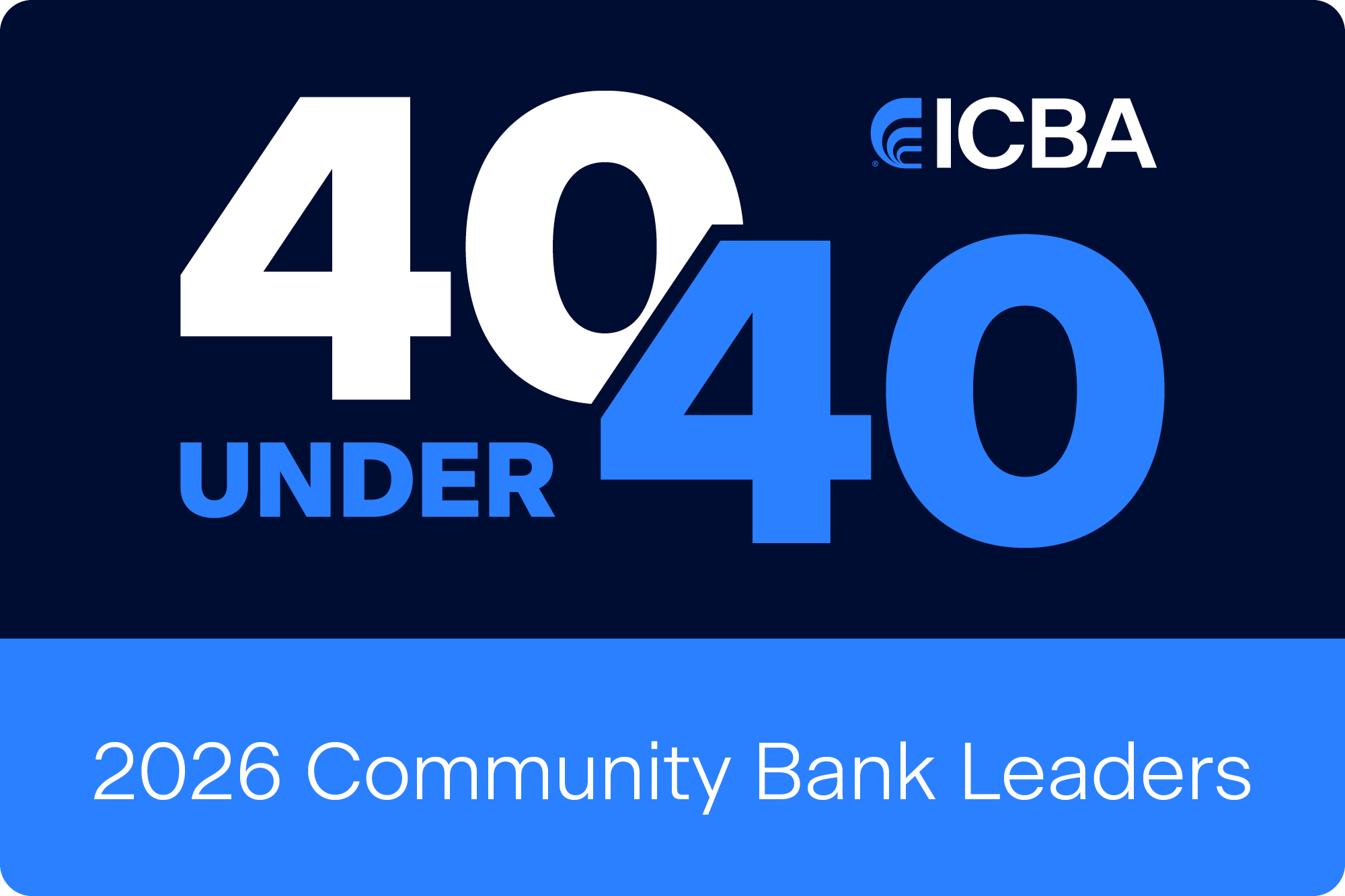The first few weeks of an employee starting a new job are pivotal in terms of how they’ll connect to the bank and their role. We spoke with community bankers about how they perfected their onboarding processes.
6 ways community banks can build a better onboarding experience
April 05, 2023 / By Mindy Charski
The first few weeks of an employee starting a new job are pivotal in terms of how they’ll connect to the bank and their role. We spoke with community bankers about how they perfected their onboarding processes.
On Alec Meyer’s first day as a mortgage lender at United Community Bank in Perham, Minn., a human resources officer walked him around the branch to meet his new coworkers. A branded Yeti water bottle, notebook and other gear welcomed him to his new desk that day in March 2022.
Quick Stat
2.6
The number of times more likely that employees with an exceptional onboarding experience are to be “extremely satisfied” with their workplace
Source: Gallup
Meyer has a bachelor’s degree in finance but didn’t have prior lending experience. So, in addition to the swag and meet-and-greets, his onboarding included a few weeks of online training, in-person events and job shadowing.
In his second month, he was ready to originate mortgage loans at the $320 million-asset community bank, and his enthusiasm for his new employer ran high. “Our onboarding process made sure you felt a part of the United Community Bank family from day one,” says Meyer. “My onboarding experience here also had a heavy focus on getting to know me as a person and how the bank can do its best to help me succeed in my role as a mortgage lender.”
His first few days of onboarding went so well, in fact, that he told his wife he had found his “forever job.”
“You have to do everything you can to really roll out the red carpet and show them that this is a great place to work and stand behind that.”–Ashley Phillips, United Community Bank
Such is the power of welcoming new employees in a warm and comprehensive way. According to a recent Gallup study, employees with an exceptional onboarding experience are 2.6 times as likely to be “extremely satisfied” with their workplace. On the other hand, a poor onboarding experience can contribute to the costly problem of high turnover.
“If you give someone a bad onboarding experience, they’re likely not going to stay,” says Ashley Phillips, the human resources officer at United Community Bank who accompanied Meyer on his initial branch tour. “Everyone is hiring right now, so you have to do everything you can to really roll out the red carpet and show them that this is a great place to work and stand behind that.”
“The moment they accept an offer, we want to start sharing with them who we are as an organization, what we value the most, what our culture is like and what they can expect on day one.”–Kari Bowman, Gateway First Bank
According to community bank executives and other HR experts, onboarding today has to be more than just paperwork, a tour of the kitchen and compliance training. Here are some best practices to consider.
1. Reach out before the job starts
Gateway First Bank in Jenks, Okla., starts the onboarding process even before a new hire’s first day. There’s a practical aspect: If someone accepts a job offer but doesn’t hear from an employer again for a couple weeks, they may explore other job opportunities, says Kari Bowman, director, learning and development of the $2 billion-asset community bank.
Quick Stat
6
The number of months Gateway First Bank’s onboarding process lasts
“The moment they accept an offer, we want to start sharing with them who we are as an organization, what we value the most, what our culture is like and what they can expect on day one,” Bowman says. “We really start engaging them and integrating them into our culture and getting them pumped up for their new position.”
Simple gestures can help new hires quickly feel like they’re a member of the team. Central Valley Community Bank (CVCB), a $2.4 billion-asset institution in Fresno, Calif., mails new employees a welcome card signed by its team members.
Midwest Bank in Norfolk, Neb., sends a welcome box with branded swag like a T-shirt, water bottle, notebook and pens. “Every new employee we've had always mentions when they come on board, ‘Wow, we really appreciated that gift we got in the mail,’” says Sue Bachman, senior vice president and human resources manager at the $993 million-asset community bank.
The bank also lets new hires know what to expect during their initial days at work. “Each day is mapped out of who they’ll be with and where they’ll be for those first couple weeks,” Bachman says.
2. Offer a warm welcome
A tried-and-true way an organization can make employees feel embraced is to take them out to lunch, but banks can go even further.
New employees at Midwest Bank meet with HR executives on their first day to pick their benefits. “We go through it with them and explain things,” says Amy Schroeter, the bank’s vice president and HR. “We've had a lot of employees tell us that they've never had a personalized touch like that.”
One way CVCB makes new team members feel welcome is by demonstrating that it has diligently prepared for their arrival. The bank shares a “preboarding checklist” with the new employee’s manager, for example, and focuses on tasks like preparing their position-specific training, printing business cards, putting a nameplate on their workstation and ensuring the workspace is ready for them on day one.
CVCB also assigns a “team buddy” so new hires “have a direct work connection from day one,” says Dawn Cagle, EVP, chief human resources officer.
3. Communicate the culture
“Culture is important, because it ends up being the unofficial rules or policies that guide you in your decision-making and behaviors,” says Valerie Utsey, EVP and chief human resources officer at ICBA. “It’s important that every employee embodies them, so we are all on the same page.”
ICBA finds that pairing a new employee with a colleague during onboarding is beneficial. “Having someone who’s been around for a while to help the new hire navigate and understand some of those unwritten things helps to reinforce the culture,” Utsey says.
One way Gateway First Bank helps communicate its culture is by sending videos via email. The videos feature short interviews with staffers who share what the culture means to them and what they like about working at the bank.
At Midwest Bank, an executive who specializes in culture and communications meets with new hires during their first week. She explains the history of the bank and other important aspects of the organization.
4. Prioritize training
Jennifer Morehead, CEO of Flex HR, a consulting firm in Johns Creek, Ga., says there’s usually a very clear connection between training and retention.
At United Community Bank, new tellers shadow two experienced tellers for a few weeks at its main branch, which is also its busiest. Phillips predicts employees who don’t have that kind of training would be more likely to bail. “They’re going to feel way overwhelmed and stressed if you are expecting them to just jump into a window and help a customer without having the proper training,” she says.
Phillips adds that trainers ask whether new employees learn by watching or doing and adjust accordingly. “People have different learning styles, and if you try to force one style on someone, they may not be successful,” she says. “[Training] doesn’t always have to be one-size-fits-all.”
Gateway First Bank has begun introducing what it calls “eLearning modules” on a variety of subjects. Some are specific to lines of business or focus on soft skills. Others are part of the onboarding process, like courses relating to culture, software or diversity.
In addition, a virtual instructor-led training may complement an on-demand module. Bowman says a course that introduces the bank’s mission and core values, for example, may be followed by a training event that discusses how the values apply to the work of employees.
These online resources are useful for engaging team members who work onsite or remotely. “It’s important that everybody has the same experience from a corporate-level onboarding process,” she says.
5. Describe employee growth
Morehead says workers are increasingly expecting employers to provide professional development and learning. “It keeps the job interesting, and it makes them a more valuable employee to the organization,” she says.
Indeed, CVCB wants new hires to understand the professional development opportunities that are available within the bank from day one. “We want our team members to be assured that their time with CVCB is more than a job; it is a career they can count on now and for their future,” Cagle says.
Gateway First Bank embraces a similar view. “[New hires] need to know that as soon as they are comfortable with their position, there’s opportunity for growth outside of that,” Bowman says. “Being able to see your career progression and create goals and really focus on your development to move to the next level is something that’s very desirable in an organization.”
6. Schedule check-ins
Onboarding can be a lengthy process; it lasts at least six months at Gateway First Bank. “It takes about that long for someone to really start to get comfortable with their position and their job duties and understand the organization and really kind of start to feel like they’re a part of the company,” Bowman says.
During those months, people at many levels of the bank engage with new employees. This may include their manager, their manager’s boss and the recruiter with whom they interviewed.
“It’s just making sure that they know they’re supported,” Bowman says. “And they’re able to see that they’re a part of something bigger than just where they sit—the four walls in their office—and what they do every day.”
Midwest Bank likewise wants new employees to know they haven’t been forgotten after they’ve settled in. The bank’s culture and communications executive reaches back out to new hires a few weeks after their start date to see how they’re doing, and if they’re in training, to see how it’s going.
In addition, a supervisor will conduct and present a 90-day evaluation of a new hire that largely revolves around whether they’re a good fit for Midwest Bank and vice versa.
Managers at United Community Bank, meanwhile, conduct a 60-day review to give new staffers performance feedback. At that time, employees do their own review about their onboarding experience and outstanding needs. They’re asked, for instance, “What can your manager do to help you do your best work here?”
Morehead points out that regular one-on-one meetings between managers and new direct reports are also important. They can provide opportunities for managers to gather information, like what motivates an employee, how work fits into their life and how they can best work together.
“You want to think your recruitment process is in line so that you bring the best people to your organization, but once they’re there, you can’t just desert them,” she says. “You are in a relationship with them, employer to employee, for hopefully a long time to come. A good relationship is more deposits than it is withdrawals.”
Community Bank of Santa Maria: an onboarding rotation
New officers at Community Bank of Santa Maria spend their first two weeks in a rotation at in every department and at both branches of the $400 million-asset community bank in Santa Maria, Calif.
The rotation gives new hires a unique view of how employees operate on a level of respect, teamwork and service, says president and CEO Janet Silveria. “The primary goal is just to immerse them in the culture and let them see that it really is lived out at every level, in every department, in every branch,” she says.
Officers also learn about what different departments do and gain an understanding of the workflow. Having fresh eyes on every aspect of the bank has a potential bonus benefit: process improvements.
“We reward staff members for saying, ‘That’s stupid,’ or asking, ‘Why do we do this?’” Silveria says. “We actually get really good feedback from new employees.”
The immersion has an important social aspect as well. “For the employee, I think it makes them feel like they’re part of the team right from the get-go,” she says. “They’ve been exposed to every department, and they have all these faces behind all the names.”
The business case for an engaging onboarding process
The financial services sector hasn’t been immune to the Great Resignation. In 2022, turnover for nonofficer bank employees reached 23.4%, its highest level since 2019, according to Crowe. The accounting, consulting and technology firm also found that 54% of banks said retaining younger talent is “somewhat challenging.”
People leave jobs for many reasons, but it’s easy to see how not being treated well in the early days can spur dissatisfaction—and how that perceived treatment can become a costly misstep.
“If you’re not training [new hires] correctly and giving them the proper support, it’s just going to be more expensive in the long run than if you had just invested in the right procedures and training in the first place,” says Jennifer Morehead, CEO of Flex HR.
Turnover creates other problems for the organization. “It’s bad for customers,” says Janet Silveria, president and CEO of Community Bank of Santa Maria in Santa Maria, Calif., “and it’s bad for other employees who see people coming and going.”
Subscribe now
Sign up for the Independent Banker newsletter to receive twice-monthly emails about new issues and must-read content you might have missed.
Sponsored Content
Featured Webinars
Join ICBA Community
Interested in discussing this and other topics? Network with and learn from your peers with the app designed for community bankers.
Subscribe Today
Sign up for Independent Banker eNews to receive twice-monthly emails that alert you when a new issue drops and highlight must-read content you might have missed.
News Watch Today

Join the Conversation with ICBA Community
ICBA Community is an online platform led by community bankers to foster connections, collaborations, and discussions on industry news, best practices, and regulations, while promoting networking, mentorship, and member feedback to guide future initiatives.













